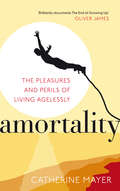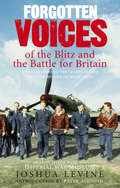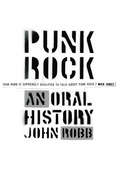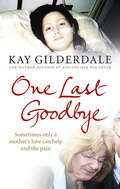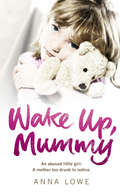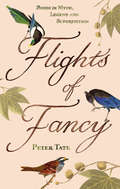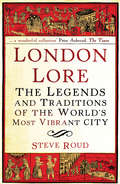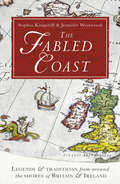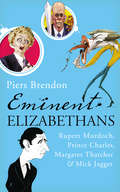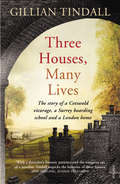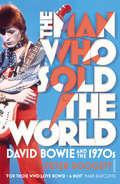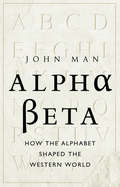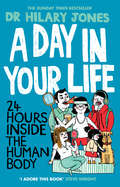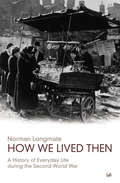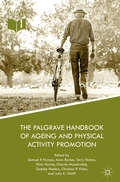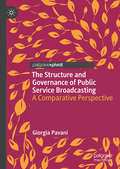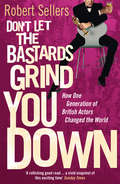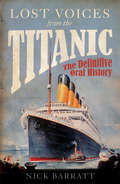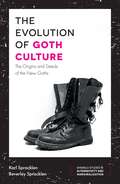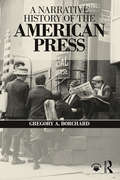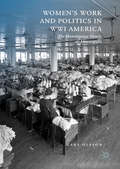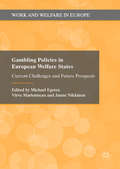- Table View
- List View
Amortality: The Pleasures and Perils of Living Agelessly
by Catherine MayerDoes your real age match the age you feel?When do we reach middle age?When, if ever, are we old?The way we age and the way we perceive age has changed radically. As we embrace new experiences, relationships and gadgets, we barely stop to look at our watches let alone consider whether our behaviour is 'age appropriate'.In this provocative and timely book, Catherine Mayer looks at the forces that created amortality - the term she coined to describe the phenomenon of living agelessly. As she follows this social epidemic through generations and across continents, she reveals its profound impact on society, our careers, our families and ourselves.Why be defined by numbers?Are you amortal?
Forgotten Voices of the Blitz and the Battle For Britain: A New History in the Words of the Men and Women on Both Sides (Forgotten Voices Ser.)
by Joshua LevineDrawing material from the Imperial War Museum's extensive aural archive, Joshua Levine brings together voices from both sides of the Blitz and the Battle of Britain to give us a unique, complete and compelling picture of this turbulent time.In June 1940, British citizens prepared for an imminent German onslaught. Hitler's troops had overrun Holland, Belgium and France in quick succession, and the British people anticipated an invasion would soon be upon them. From July to October, they watched the Battle of Britain play out in the skies above them, aware that the result would decide their fate. Over the next nine months, the Blitz killed more than 43,000 civilians. For a year, the citizens of Britain were effectively front-line soldiers in a battle which united the country against a hated enemy.We hear from the soldiers, airmen, fire-fighters, air-raid wardens and civilians, people in the air and on the ground, on both sides of the battle, giving us a thrilling account of Britain under siege. With first-hand testimonies from those involved in Dunkirk and the Battle of Britain, Black Saturday on 7th September 1940 when the Luftwaffe began the Blitz, to its climax on the 10th May 1941, this is the definitive oral history of a period when Britain came closer to being overwhelmed by the enemy than at any other time in modern history.
Punk Rock: An Oral History
by John Robb'To see The Clash on the White Riot tour was like discovering how to be a rock star: you just did it yourself. You didn't wait for someone to come and discover you. That was the most important thing that came out of punk... We came home and we cut our hair and bought skinny trousers. It was year zero. That was the moment for me' Billy BraggPunk Rock is a book like no other. It is an oral history of a radical movement which exploded in Seventies Britain. With its own clothes, hair, artwork, fanzines and radical politics, Punk boasted a DIY ethos that meant anyone could take part. The scene was uniquely vibrant and energetic, leaving an extraordinary legacy of notorious events, charismatic characters and inspirational music. John Robb has spent over a year interviewing more than 100 contributors including Glen Matlock, Mick Jones, Don Letts, Slash, Billy Bragg, Hugh Cornwell and Captain Sensible. Now, for the first time, they give the inside view on events such as The Sex Pistols' swearing live on the Bill Grundy TV show and staging their anti-Jubilee riverboat party on the Thames, famous gigs at The Roxy and 100 Club, and the groundbreaking records by The Pistols, The Clash, The Damned and others.From the widely debated roots of punk in the late-Sixties through to the fallout of the post-punk period in 1984, and the ongoing influence on today's bands, Punk Rock is the definitive oral history of an inimitable and exciting movement.
One Last Goodbye: Sometimes only a mother's love can help end the pain
by Kay GilderdaleWatching her child die is the hardest thing a mother can ever do. But for Kay Gilderdale, saying a final goodbye to her only daughter Lynn was exceptionally painful: she'd played a part in her death.Lynn was just 14 when she was struck down by the crippling disease ME, leaving her paralysed and in constant agony. Over the next 17 years, she became desperate to escape her miserable existence, even begging her mum to help her die. So, one night, when Kay found Lynn attempting suicide, she was forced to make an impossible decision. Continue watching her child suffer or help her end the pain?Eventually, fighting her every instinct, Kay helped her precious daughter take a fatal overdose. But while Lynn was finally free, her mother faced a fresh agony - a possible lifetime behind bars. The highly controversial trial that followed opened a fierce public debate on assisted suicide. Is it murder or mercy?Here, in her heartbreaking story, Kay reveals the harrowing truth behind the headlines and the desperate lengths a mother will go to for the love of a child.
Wake Up, Mummy: The heartbreaking true story of an abused little girl whose mother was too drunk to notice
by Anna Lowe'I squeezed through the narrow gap and out into the hallway and I stood for a moment, unable to decide where to go. Should I make a dash for the kitchen, where my mother would be swigging from a bottle? Or should I run upstairs and try to find somewhere to hide? It was a choice I didn't really need to make, because there was no escape'Anna Lowe grows up on the doorsteps of pubs, waiting for her mum to come out. Having to give up her bedroom to her mother's drunken friends. And regularly calling out the ambulance, after finding her mother unconscious and covered in vomit. But it is when they move in with her mother's boyfriend Carl that things take the ugliest turn. Not only is he violent with her mother, but he also sexually abuses Anna from the age of six - destroying any semblance of normal childhood she had left. Wake Up, Mummy is the heartbreaking true story of a little girl who eventually found the courage to break free from the past.
Flights of Fancy: Birds in Myth, Legend and Superstition
by Peter TateDid you know that Barnacle geese were once classified as fish? That both the Cherokees and the ancient Greeks were convinced that cranes regularly fought battles with pygmies? That the Swiss believed that any cuckoo that managed to survive for a year would turn into an eagle?Throughout history, birds have fascinated and intrigued mankind, so it is hardly surprising that an astonishingly rich body of myth, legend and superstition has grown up around them. Flights of Fancy explores the stories told about 30 of the world's best-known species, from the blackbird to the wryneck, drawing on traditions from every quarter of the globe. Some of the stories included clearly arose as a result of faulty observation, such as the widely held belief that nightjars sucked milk from cows. Others stemmed from attempts to explain unusual aspects of appearance or behaviour. But the vast majority seem to have their origins in people's delight in inventing stories - whether the legend that the blackbird was originally white, or the suggestion that witches kept owls as their familiars. And, as Peter Tate points out, what is so extraordinary is that the same story often crops up in many different parts of the world: the belief that eagles and snakes are sworn enemies can be found as far apart as Iraq and Mexico; the view that the raven is the harbinger of bad luck can be found throughout Europe from Denmark to Spain.A fascinating and wonderfully entertaining read, this is the ideal book for anyone interested in birds or myths - or both.
London Lore: The legends and traditions of the world's most vibrant city
by Steve RoudIn which part of North London were wild beasts once thought to roam the sewers? Why did 1920s working-class Londoners wear necklaces of blue beads?Who was the original inspiration for the 'pearly king' costume?And did Spring-heeled Jack, scourge of Victorian London, ever really exist?Exploring everything from local superstitions and ghost stories to annual customs, this is an enchanting guide to the ancient legends and deep-rooted beliefs that can be found the length and breadth of the city.
The Fabled Coast: Legends & traditions from around the shores of Britain & Ireland
by Sophia Kingshill Jennifer Beatrice WestwoodPirates and smugglers, ghost ships and sea-serpents, fishermen’s prayers and sailors’ rituals – the coastline of the British Isles plays host to an astonishingly rich variety of local legends, customs, and superstitions.In The Fabled Coast, renowned folklorists Sophia Kingshill and Jennifer Westwood gather together the most enthralling tales and traditions, tracing their origins and examining the facts behind the legends. Was there ever such a beast as the monstrous Kraken? Did a Welsh prince discover America, centuries before Columbus? What happened to the missing crew of the Mary Celeste? Along the way, they recount the stories that are an integral part of our coastal heritage, such as the tale of Drake’s Drum, said to be heard when England was in peril, and the mythical island of Hy Brazil, which for centuries appeared on sea charts and maps to the west of Ireland. The result is an endlessly fascinating, often surprising journey through our island history.
Eminent Elizabethans: Rupert Murdoch, Prince Charles, Margaret Thatcher & Mick Jagger
by Dr Piers BrendonMargaret Thatcher, Rupert Murdoch, Prince Charles, Mick Jagger - four figures who have illuminated our age.·Margaret Thatcher – the first female Prime Minister, who dedicated herself with messianic zeal to breaking the mould of post-war British politics·Rupert Murdoch – the billionaire media mogul whose empire, built on an ethical void, has polluted the channels of communication from London to Sydney, from New York to New Guinea·Prince Charles – the royal dilettante whose erratic exploits shook the throne and put his own succession to it at risk·Mick Jagger – lead singer of the Rolling Stones, who embodied the sixties counter-culture of sex and drugs and rock ‘n’ roll yet aspired to be a gentleman and accepted a knighthood at the behest of Tony Blair.A sequel to Brendon’s bestselling Eminent Edwardians, Eminent Elizabethans is written in the same witty, ironic and irreverent style and reveals how each one played out a major theme in the new Elizabethan medley. Each is vividly and vitally depicted through pungent anecdote, piquant quotation and mordant commentary. In short, these brilliant miniatures are as entertaining as they are illuminating.
Three Houses, Many Lives
by Gillian Tindall‘A major achievement' Ronald Blythe, author of AkenfieldA Cotswold vicarage.A former girls' boarding school in Surrey.A Jacobean house now buried in inner London.Three Houses, Many Lives tells the stories not only of the houses themselves but of the lives of the many people who lived in them. From Eugenia Stanhope who sold Lord Chesterfield's scandalous letters, to the autocratic vicar who held the same parish from age 28 to 82, from the just-literate wife of a parish clerk who wrote riddles in his registers, to the cow-keeper who farmed 226 acres in Hornsey till he sold them profitably when the railways came through. Gillian Tindall is a master of miniaturist history, making a particular place, person or situation stand for a much larger picture.
The Man Who Sold The World: David Bowie And The 1970s
by Peter DoggettNo artist offered a more incisive and accurate portrait of the troubled landscape of the 1970s than David Bowie. Cultural historian Peter Doggett explores the rich heritage of Bowie's most productive and inspired decade, and traces the way in which his music reflected and influenced the world around him. From 'Space Oddity', his dark vision of mankind's voyage into the unknown terrain of space, to the Scary Monsters album, Doggett examines in detail Bowie's audacious creation of an 'alien' rock star, Ziggy Stardust, and his increasingly perilous explorations of the nature of identity and the meaning of fame.Mixing brilliant musical critique with biographical insight and acute cultural analysis, The Man Who Sold The World is a unique study of a major artist and his times.
Alpha Beta: How The Alphabet Shaped The Western World
by John ManThe idea behind the alphabet - that language with all its wealth of meaning can be recorded with a few meaningless signs - is an extraordinary one. So extraordinary, in fact, that it has occurred only once in human history: in Egypt about 4000 years ago. Alpha Beta follows the emergence of the western alphabet as it evolved into its present form, contributing vital elements to our sense of identity along the way. The Israelites used it to define their God, the Greeks to capture their myths, the Romans to display their power. And today, it seems on the verge of yet another expansion through the internet.Tracking the alphabet as it leaps from culture to culture, John Man weaves discoveries, mysteries and controversies into a story of fundamental historical significance.
A Day in Your Life: 24 Hours Inside the Human Body
by Dr Hilary JonesHave you ever wondered why it takes so long to get out of bed in the morning? And why you always wake up bursting for a pee? Why that small blackhead has erupted into a hideous red spot overnight? And why stepping into a hot shower gives you goose bumps?Following an average family and their daily routine, Dr Hilary Jones takes you on a bold and captivating journey through the human body, answering these questions and hundreds more.From how our bodies function to why they react in certain ways, Dr Hilary tackles the questions that matter and examines what makes us tick. Fascinating and highly entertaining, A Day in Your Life reveals the incredible nature of the human body.
How We Lived Then: History of Everyday Life During the Second World War, A
by Norman LongmateAlthough nearly 90% of the population of Great Britain remained civilians throughout the war, or for a large part of it, their story has so far largely gone untold. In contrast with the thousands of books on military operations, barely any have concerned themselves with the individual's experience. The problems of the ordinary family are barely ever mentioned - food rationing, clothes rationing, the black-out and air raids get little space, and everyday shortages almost none at all. This book is an attempt to redress the balance; to tell the civilian's story largely through their own recollections and in their own words.
The Palgrave Handbook of Ageing and Physical Activity Promotion
by Christina R. Victor Charles Musselwhite Samuel R. Nyman Anna Barker Terry Haines Khim Horton Geeske Peeters Julia Katharina WolffThe ageing of our population is a key societal issue across the globe. Although people are living longer, they need to be living longer in good health to continue to enjoy quality of life and independence and to prevent rises in health and social care costs. This timely and ground-breaking volume will provide an up-to-date overview of the factors that promote physical activity in later life. Despite advances in the fields of gerontology and geriatrics, sports and exercise science, sociology, health psychology, and public health, knowledge is largely contained within disciplines as reflected in the current provision of academic texts on this subject. To truly address the present and substantial societal challenges of population ageing, a multidisciplinary and collaborative approach is required. This handbook will inform researchers, students, and practitioners on the current evidence base for what physical activities need to be promoted among older people and how they can be implemented to maximise engagement. This handbook will be an invaluable resource for researchers, practitioners, policy makers, and students across the social sciences.
The Structure and Governance of Public Service Broadcasting: A Comparative Perspective
by Giorgia PavaniThis book offers an analysis of public service broadcasting (PSB) in European Countries that highlights the issues – both legal and not – currently facing PSB. Focusing particularly on the link between public TV and the political class, Giorgia Pavani offers an overview of the structure and governance of PSB from both a comparative and international viewpoint. The text is a useful research tool for those who want to study PSB from a viewpoint that goes beyond the legal perspective, and helps the reader to further understand the phenomenon of influence on public TV policy. By combining new comparative approaches in the studies of PSB with a detailed and updated analysis of International, European and comparative law, the result is an innovative and multidisciplinary volume that seeks to unpick the relationship between PSB and politics.
The Structure and Governance of Public Service Broadcasting: A Comparative Perspective
by Giorgia PavaniThis book offers an analysis of public service broadcasting (PSB) in European Countries that highlights the issues – both legal and not – currently facing PSB. Focusing particularly on the link between public TV and the political class, Giorgia Pavani offers an overview of the structure and governance of PSB from both a comparative and international viewpoint. The text is a useful research tool for those who want to study PSB from a viewpoint that goes beyond the legal perspective, and helps the reader to further understand the phenomenon of influence on public TV policy. By combining new comparative approaches in the studies of PSB with a detailed and updated analysis of International, European and comparative law, the result is an innovative and multidisciplinary volume that seeks to unpick the relationship between PSB and politics.
Don't Let the Bastards Grind You Down: How One Generation of British Actors Changed the World
by Robert SellersAlan Bates, Michael Caine, Sean Connery, Tom Courtenay, Albert Finney, Richard Harris, Peter O'Toole, Robert Shaw and Terence Stamp: They are the most formidable acting generation ever to tread the boards or stare into a camera, whose anti-establishment attitude changed the cultural landscape of Britain.This was a new breed, many culled from the working class industrial towns of Britain, and nothing like them has been seen before or since. Their raw earthy brilliance brought realism to a whole range of groundbreaking theatre from John Osborne's Look Back in Anger to Joan Littlewood and Harold Pinter and the creation of the National Theatre. And they ripped apart the staid, middle-class British film industry with kitchen-sink classics like Saturday Night and Sunday Morning, This Sporting Life, The Loneliness of the Long Distance Runner, A Kind of Loving and Billy Liar before turning their sights on international stardom: Connery with James Bond, O'Toole as Lawrence of Arabia, Finney with Tom Jones and Caine in Zulu.Don't Let the Bastards Grind You Down brings alive the trail-blazing period of theatre and film from 1956-1964 through the vibrant energy and exploits of this revolutionary generation of stars who bulldozed over austerity Britain and paved the way for the swinging 60s. What Peter Biskind's Easy Riders Raging Bulls did for American cinema writing so Don't Let the Bastards will do for the British cinema.
Lost Voices from the Titanic: The Definitive Oral History
by Nick BarrattStarting from its original conception and design by the owners and naval architects at the White Star Line through construction at Harland and Wolff's shipyards in Belfast, Nick Barratt explores the pre-history of the Titanic. He examines the aspirations of the owners, the realities of construction and the anticipation of the first sea-tests, revealing that the seeds of disaster were sown by the failure to implement sealed bulkheads - for which the original plans are now available. Barratt then looks at what it was like to embark on the Titanic's maiden voyage in April 1912. The lives of various passengers are examined in more detail, from the first class aristocrats enjoying all the trappings of privilege, to the families in third-class and steerage who simply sought to leave Britain for a better life in America. Similarly, the stories of representatives from the White Star Line who were present, as well as members of the crew, are told in their own words to give a very different perspective of the voyage.Finally, the book examines the disaster itself, when Titanic struck the iceberg on 14 April and sunk hours later. Survivors from passengers and crew explain what happened, taking you back in time to the full horror of that freezing Atlantic night when up to 1,520 people perished. The tragedy is also examined from the official boards of enquiry, and its aftermath placed in a historic context - the damage to British prestige and pride, and the changes to maritime law to ensure such an event never took place again. The book concludes by looking at the impact on those who escaped, and what became of them in the ensuing years; and includes the words of the last living survivor, Millvina Dean.
The Evolution of Goth Culture: The Origins and Deeds of the New Goths (Emerald Studies in Alternativity and Marginalization)
by Karl Spracklen Beverley SpracklenThe origins and deeds of the old Goths were constructed by Roman historians in fear of the Goth as a barbarian outsider; at the same time, the Goths were themselves the heroic subject of their own histories, constructed by their supporters as stories of their mythical origin and the deeds that led them to be rulers of their own kingdoms in post-Roman Late Antiquity. Who the old Goths were, their origins and their deeds, was a product of history, historiography and myth-making. In this book, Spracklen and Spracklen use the idea of collective memory to explore the controversies and boundary-making surrounding the genesis and progression of the modern gothic alternative culture. Spracklen and Spracklen argue that goth as sub-culture in the eighties was initially counter cultural, political and driven by a musical identity that emerged from punk. However, as goth music globalised and became another form of pop and rock music, goth in the nineties retreated into an alternative sub-culture based primarily on style and a sense of transgression and profanity. By this century goth became the focus of teenage rebellions, moral panics and growing commodification of counter-cultural resistance, so that by the goth has effectively become another fashion choice in the late-modern hyper-real shopping malls, devoid generally of resistance and politics. Goth, like punk, is in danger of being co-opted altogether by capitalism. This book suggests that the only way for goth culture to survive is if it becomes transgressive and radical again.
A Narrative History of the American Press
by Gregory A. BorchardBeginning with the American Revolution and spanning over two hundred years of American journalism, A Narrative History of the American Press provides an overview of the events, institutions, and people who have shaped the press, from the creation of the First Amendment to today. Gregory A. Borchard’s introductory text helps readers develop an understanding of the role of the press in both the U.S. and world history, and how American culture has shaped—and been shaped by—the role of journalism in everyday life. The text, along with a rich array of supplemental materials available online, provides students with the tools used by both reporters and historians to understand the present through the past, allowing readers to use the history of journalism as a lens for implementing their own storytelling, reporting, and critical analysis skills.
Women's Work and Politics in WWI America: The Munsingwear Family of Minneapolis
by Lars OlssonBy World War I, the Northwestern Knitting Company was the largest workplace for gainfully employed women in Minnesota and the largest garment factory in the United States. Lars Olsson investigates the interplay of class, gender, marital status, ethnicity, and race in the labor relations at the factory, illuminating the lives of the women who worked there. Representing thirty nationalities, particularly Scandinavian, the women worked long hours for low pay in roles that were strictly divided along ethnic and gendered lines, while the company directors and stockholders made enormous profits off of their labor. Management developed paternal strategies to bind the workers to the company and preempt unionization, including bonus programs, minstrel shows, and a pioneering industrial welfare program. With the US entry into the war, the company was contracted to produce underwear for soldiers, and management expanded the metaphor of "the Munsingwear Family" to construct not just company loyalty, but national loyalty. This book sheds new light on women's labor in WWI and the lives of textile workers in the United States.
Women's Work and Politics in WWI America: The Munsingwear Family of Minneapolis
by Lars OlssonBy World War I, the Northwestern Knitting Company was the largest workplace for gainfully employed women in Minnesota and the largest garment factory in the United States. Lars Olsson investigates the interplay of class, gender, marital status, ethnicity, and race in the labor relations at the factory, illuminating the lives of the women who worked there. Representing thirty nationalities, particularly Scandinavian, the women worked long hours for low pay in roles that were strictly divided along ethnic and gendered lines, while the company directors and stockholders made enormous profits off of their labor. Management developed paternal strategies to bind the workers to the company and preempt unionization, including bonus programs, minstrel shows, and a pioneering industrial welfare program. With the US entry into the war, the company was contracted to produce underwear for soldiers, and management expanded the metaphor of "the Munsingwear Family" to construct not just company loyalty, but national loyalty. This book sheds new light on women's labor in WWI and the lives of textile workers in the United States.
Gambling Policies in European Welfare States: Current Challenges and Future Prospects (Work and Welfare in Europe)
by Michael Egerer Virve Marionneau Janne NikkinenThis edited book draws on a cross-cultural and historical lens to theoretically and practically analyse gambling regulations and the use of gambling revenue. It takes on a broad spectrum of perspectives, from the origin of the money, to the regulators, operators and beneficiaries of gambling, and looks at the interests, networks and power relations involved.This multidisciplinary collection elicits a shift in analysis, shedding light on a broader societal, historical and economic view of gambling and gambling policies, by its attention to implicit networks of power, influential legislation, gambling provision and infrastructure.Gambling Policies in European Welfare States will be of interest to students and scholars alike who are seeking cross-national and interdisciplinary analyses of welfare, politics, sociology and economics.
Gambling Policies in European Welfare States: Current Challenges and Future Prospects (Work and Welfare in Europe)
by Michael Egerer Virve Marionneau Janne NikkinenThis edited book draws on a cross-cultural and historical lens to theoretically and practically analyse gambling regulations and the use of gambling revenue. It takes on a broad spectrum of perspectives, from the origin of the money, to the regulators, operators and beneficiaries of gambling, and looks at the interests, networks and power relations involved.This multidisciplinary collection elicits a shift in analysis, shedding light on a broader societal, historical and economic view of gambling and gambling policies, by its attention to implicit networks of power, influential legislation, gambling provision and infrastructure.Gambling Policies in European Welfare States will be of interest to students and scholars alike who are seeking cross-national and interdisciplinary analyses of welfare, politics, sociology and economics.
